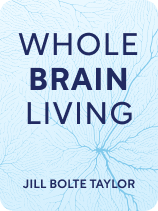

This article is an excerpt from the Shortform book guide to "Whole Brain Living" by Jill Bolte Taylor. Shortform has the world's best summaries and analyses of books you should be reading.
Like this article? Sign up for a free trial here.
Are you stressed out and in need of a break? How can you live peacefully?
There are four “characters” in your brain that work together to bring inner peace to your life. It’s not until you learn how to coordinate all four characters that you’re able to achieve said peace.
Let’s dive into how to live peacefully, using Jill Bolte Taylor’s amazing advice from Whole Brain Living.
How Can Your Four Characters Bring Inner Peace?
The four characters are as follows:
- Left-side cerebral cortex
- Left-side limbic system
- Right-side cerebral cortex
- Right-side limbic system
Taylor writes that there’s no one right way to coordinate your four characters. She says that to learn how to live peacefully, we must listen to all four of the characters and make sure each of them feels valued. Then, when you’ve acknowledged what each of them offers in a particular circumstance, you can be intentional about which character you want to embody as you move forward. In this section, we’ll dive into some actionable advice to achieve this.
(Shortform note: Taylor’s recommendation of getting to know and validating each of your four characters to achieve inner peace is similar to the IFS technique that Schwartz describes in No Bad Parts. However, in addition to identifying “parts”—the internal beings who exhibit different personalities—Schwartz identifies an additional player: the fundamental “Self” who acts as the wise and compassionate caretaker of the other internal beings. While Taylor implies that there must be some executive “you” who decides which character will take the lead in a situation, she doesn’t go so far as to name the core “Self” as independent from the other characters like Schwartz does.)
BRAIN Technique
Taylor’s main strategy for attuning yourself to your four characters is what she calls the “Brain Huddle.” This means mentally getting the four characters together to listen to their input, and then agreeing on a plan—much like an athletic team’s huddle during a game. Taylor recommends using the acronym BRAIN and breaks down each step as follows:
B—Breathe: Take some deep breaths to take control of any automatic initial responses your body may be having. Remember that after 90 seconds, the physiological response to an emotion will pass, and you’ll then have the opportunity to decide how to act next.
R—Recognize: Taylor says to recognize what character is dominating your mindset. Think about their personalities and reflect on your behavior in the moment.
A—Appreciate: Next, Taylor recommends appreciating the dominant character as well as your other characters simply for existing. Remember that each has value and importance in your life.
I—Inquire: At this point, let each character express their point of view by thinking through the scenario from the perspective of each one. Taylor says that after consideration, decide on the best course of action—ideally aiming for a peaceful resolution.
N—Navigate: The last step is navigating the outcome of your decision in the previous step. Taylor points out that regardless of your choices, you can’t control other people’s reactions, but you can respond thoughtfully. For example, if you’re in the middle of an argument with your parent, who insists on staying in a hostile and fear-driven mindset, you may need to put your most empathic, compassionate Character 4 forward to respond to their Character 2 and de-escalate the conflict.
Tips for Using the BRAIN Technique
Beyond detailing the main steps of the BRAIN technique, Taylor describes a few tips for how to use this strategy in your daily life to improve your relationships with others, improve your emotional well-being, and master the art of embodying each character when you need them.
Tip 1: Get to Know Other People’s Characters
Since everyone you interact with has their own four characters with conflicting desires and personalities, we can improve our relationships with others by increasing our awareness of their characters. For example, you might recognize that your friend embodies their joyful Character 3 when you go hiking together, but they tend to shift into their hostile Character 2 when you play competitive board games. Then, you can use these insights to maintain a positive dynamic (perhaps stick to hiking) or talk with them about negative patterns (“Why do you always flip the Monopoly board when I win?”).
Tip 2: Check in Regularly With Your Four Characters
Taylor says that like with other skills, using the BRAIN technique to your advantage takes practice. She recommends making the BRAIN strategy a habit by going through the steps regularly: for example, every morning when you wake up, nightly before bed, whenever you feel a strong emotion coursing through your body, or when you’re in the middle of an interpersonal conflict. Taylor says that when you choose a specific mental pathway enough times, it becomes the default. For instance, if you consistently and intentionally suppress your Character 1 (who makes you feel anxious when you’re trying to enjoy unstructured fun time), eventually your Character 3 will learn to automatically take over in those situations.
Tip 3: Recognize Patterns and Strategize in Advance
In addition, Taylor recommends using the BRAIN strategy as a tool to reflect on your behavioral patterns and strategize in advance for how you’ll react in a specific situation. For example, if using the BRAIN technique has taught you that your Character 1 likes to take control of vacation plans to the point that other people aren’t having fun, you can plan ahead (still satisfying a Character 1 urge) and avoid this problem by getting feedback from others about what they want to do or only scheduling activities for part of your next vacation.
Tip 4: Work Toward Recovery From Addiction
Taylor explains that when someone is addicted to drugs or alcohol, there are common patterns in how the characters’ dynamics play out. She says that in order to have long-term success in their recovery, all four characters have to participate in the process.

———End of Preview———
Like what you just read? Read the rest of the world's best book summary and analysis of Jill Bolte Taylor's "Whole Brain Living" at Shortform.
Here's what you'll find in our full Whole Brain Living summary:
- How you can choose to access different parts of your brain
- The four areas of the brain that perceive and navigate the world differently
- How to achieve emotional well-being by getting to know your brain better






